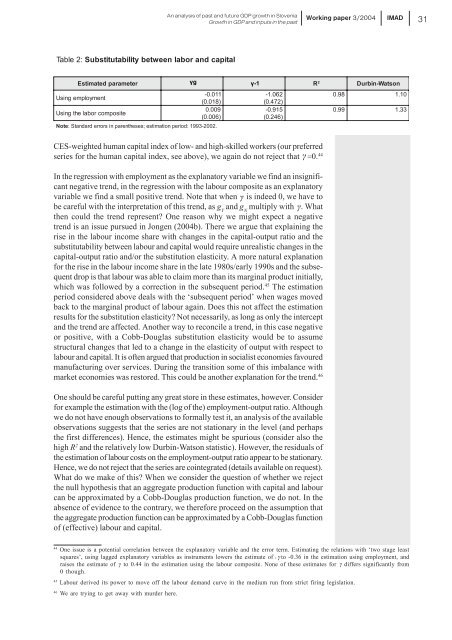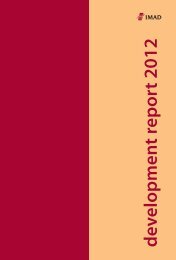Working papers published by IMAD ISSN: 1318-1920 ... - UMAR
Working papers published by IMAD ISSN: 1318-1920 ... - UMAR
Working papers published by IMAD ISSN: 1318-1920 ... - UMAR
Create successful ePaper yourself
Turn your PDF publications into a flip-book with our unique Google optimized e-Paper software.
An analysis of past and future GDP growth in Slovenia<br />
Growth in GDP and inputs in the past<br />
<strong>Working</strong> paper 3/2004<br />
<strong>IMAD</strong><br />
31<br />
Table<br />
2:<br />
Substitutability between labor and capital<br />
Estimated<br />
parameter<br />
ãg ã-1<br />
R 2 Durbin-Watso n<br />
Using employment<br />
Using the labor composite<br />
-0.011<br />
(0.018)<br />
0.009<br />
(0.006)<br />
N ote:<br />
Standard errors in parentheses; estimation period: 1993-2002.<br />
-1.062<br />
(0.472)<br />
-0.915<br />
(0.246)<br />
0.98<br />
1.10<br />
0.99<br />
1.33<br />
CES-weighted human capital index of low- and high-skilled workers (our preferred<br />
series for the human capital index, see above), we again do not reject that ã=0. ã<br />
44<br />
In the regression with employment as the explanatory variable we find an insignificant<br />
negative trend, in the regression with the labour composite as an explanatory<br />
variable we find a small positive trend. Note that when ã is indeed 0, we have to<br />
be careful with the interpretation of this trend, as g Y<br />
and g N<br />
multiply with ã. ã What<br />
then could the trend represent? One reason why we might expect a negative<br />
trend is an issue pursued in Jongen (2004b). There we argue that explaining the<br />
rise in the labour income share with changes in the capital-output ratio and the<br />
substitutability between labour and capital would require unrealistic changes in the<br />
capital-output ratio and/or the substitution elasticity. A more natural explanation<br />
for the rise in the labour income share in the late 1980s/early 1990s and the subsequent<br />
drop is that labour was able to claim more than its marginal product initially,<br />
which was followed <strong>by</strong> a correction in the subsequent period. 45 The estimation<br />
period considered above deals with the ‘subsequent period’ when wages moved<br />
back to the marginal product of labour again. Does this not affect the estimation<br />
results for the substitution elasticity? Not necessarily, as long as only the intercept<br />
and the trend are affected. Another way to reconcile a trend, in this case negative<br />
or positive, with a Cobb-Douglas substitution elasticity would be to assume<br />
structural changes that led to a change in the elasticity of output with respect to<br />
labour and capital. It is often argued that production in socialist economies favoured<br />
manufacturing over services. During the transition some of this imbalance with<br />
market economies was restored. This could be another explanation for the trend. 46<br />
One should be careful putting any great store in these estimates, however. Consider<br />
for example the estimation with the (log of the) employment-output ratio. Although<br />
we do not have enough observations to formally test it, an analysis of the available<br />
observations suggests that the series are not stationary in the level (and perhaps<br />
the first differences). Hence, the estimates might be spurious (consider also the<br />
high R 2 and the relatively low Durbin-Watson statistic). However, the residuals of<br />
the estimation of labour costs on the employment-output ratio appear to be stationary.<br />
Hence, we do not reject that the series are cointegrated (details available on request).<br />
What do we make of this? When we consider the question of whether we reject<br />
the null hypothesis that an aggregate production function with capital and labour<br />
can be approximated <strong>by</strong> a Cobb-Douglas production function, we do not. In the<br />
absence of evidence to the contrary, we therefore proceed on the assumption that<br />
the aggregate production function can be approximated <strong>by</strong> a Cobb-Douglas function<br />
of (effective) labour and capital.<br />
44<br />
One issue is a potential correlation between the explanatory variable and the error term. Estimating the relations with ‘two stage least<br />
squares’, using lagged explanatory variables as instruments lowers the estimate of ã to -0.36 in the estimation using employment, and<br />
raises the estimate of ã to 0.44 in the estimation using the labour composite. None of these estimates for ã differs significantly from<br />
0 though.<br />
45<br />
Labour derived its power to move off the labour demand curve in the medium run from strict firing legislation.<br />
46<br />
We are trying to get away with murder here.
















